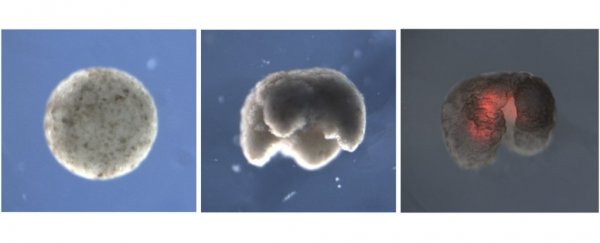In another lifetime, if they had been allowed to follow their natural development, the stem cells taken from embryonic frogs would have turned into skin and heart tissue within living, breathing animals.
Instead, in configurations designed by algorithms and constructed by humans, those cells have been assembled into something new: the first-ever robots constructed entirely out of living cells.
The creators have called them xenobots; tiny, submillimetre-sized blobs containing between 500 and 1,000 cells that have been able to scoot across a petri dish, self-organise, and even transport minute payloads. These xenobots are unlike any living organism or organ we've encountered or created to date.
The possibilities for custom living machines designed for a variety of purposes, from targeted drug delivery to environmental remediation, are pretty mind-blowing.
"These are novel living machines," said computer scientist and roboticist Joshua Bongard of the University of Vermont.
"They're neither a traditional robot nor a known species of animal. It's a new class of artifact: a living, programmable organism."
Designing the xenobots required the use of a supercomputer, and an algorithm that could virtually put together a few hundred frog heart and skin cells in different configurations (somewhat like LEGO bricks), and simulate the results.
The scientists would assign a desired outcome - such as locomotion - and the algorithm would create candidate designs aimed to produce that outcome. Thousands of configurations of cells were designed by the algorithm, with varying levels of success.
The least successful configurations of cells were tossed out, and the most successful were kept and refined, until they were about as good as they were going to get.
Then, the team selected the most promising designs to physically build out of cells harvested from embryonic African clawed frogs (Xenopus laevis). This was painstaking work, using microscopic forceps and an electrode.
When they were finally put together, the configurations were actually able to move around, as per the simulations. The skin cells act as a sort of scaffolding to hold everything together, while the contractions of the heart cell muscles are put to work to propel the xenobots.
These machines moved about an aqueous environment for up to a week without the need for additional nutrients, powered by their own 'pre-loaded' energy stores in the form of lipids and proteins.
One design had a hole through the middle in an attempt to reduce drag. This hole could be exapted into a pouch for transporting objects, the team found; as they evolved the design, they incorporated the pouch and transported an object in a simulation.
 (Kriegman et al., PNAS, 2019)
(Kriegman et al., PNAS, 2019)
The xenobots moved objects around in the real world, too. When their environment was scattered with particulates, the xenobots spontaneously worked together, moving in a circular motion to push the particulates into one spot.
It's fascinating work. According to the researchers, their efforts can provide invaluable insight into how cells communicate and work together.
"You look at the cells we've been building our xenobots with, and, genomically, they're frogs. It's 100 percent frog DNA - but these are not frogs. Then you ask, well, what else are these cells capable of building?" said biologist Michael Levin of Tufts University.
"As we've shown, these frog cells can be coaxed to make interesting living forms that are completely different from what their default anatomy would be."
Although the team calls them 'living', that may well depend on how you define living creatures. These xenobots are not able to evolve on their own, there are no reproductive organs, and they are unable to multiply.
When the cells run out of nutrients, the xenobots simply become a small clump of dead cells. (This also means they are biodegradable, which gives them another advantage over metal and plastic robots.)
Although the current state of the xenobots is relatively harmless, there is the potential for future work to incorporate nervous system cells, or develop them into bioweapons. As this field of research grows, regulation and ethics guidelines will need to be written, applied and adhered to.
But there is plenty of potential good, too.
"We can imagine many useful applications of these living robots that other machines can't do," Levin said, "like searching out nasty compounds or radioactive contamination, gathering microplastic in the oceans, travelling in arteries to scrape out plaque."
The research has been published in PNAS, and the team has made their source code freely available on Github.
